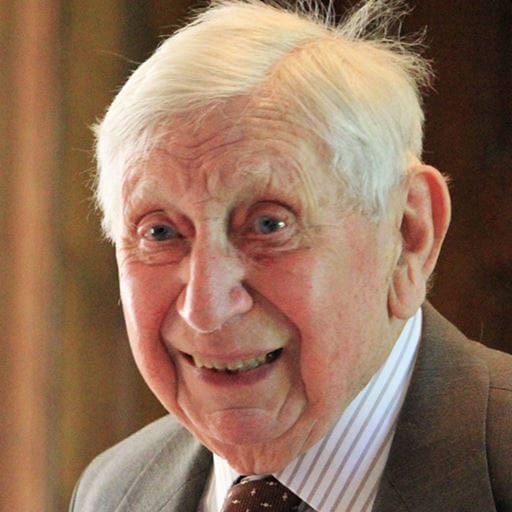The founding chair of telecommunications at the University of Essex, Professor Ken Cattermole, has died at the age of 98. His groundbreaking research on Pulse Code Modulation supported the development of the computers and mobile phones we use today.
Professor Cattermole helped establish the University of Essex’s international reputation in electronic engineering and was awarded the J J Thompson medal in 1996 from the Institution of Electrical Engineers (now known as IET) for his outstanding contribution to the development of telecommunications transmission in the UK and his innovative work on Pulse Code Modulation. The J J Thompson medal is awarded annually to individuals or teams who have made an exceptional contribution to the advancement of electronics. Laboratories at the University were also named after Professor Cattermole to mark his contribution to the University.
Professor Stuart Walker, from the School of Computer Science and Electronic Engineering, studied at Essex in the 1970s and said Professor Cattermole inspired his life-long interest in telecommunications. He added: “Ken was in at the beginning of the development of Pulse Code Modulation which turns ordinary analogue signals, including audio and video, into a digital form which can be transmitted without limit, stored forever, cleaned up and, these days, strongly encrypted as well. It really is the foundation for all the mobile phones, computers and televisions we use today.”
Professor Cattermole joined Essex in 1968 and played a major role launching and leading the very successful telecommunications programme.
The chair of telecommunications had been endowed by the British Post Office, which later became British Telecom. Professor Cattermole moved to Essex from Standard Telecommunication Laboratories (STL) in Harlow, where he was involved in pioneering the development of Pulse Code Modulation.
His book Principles of Pulse Code Modulation published in 1969 became a standard reference on the subject. He was not only a remarkable researcher, inventor and teacher in his field, but also a notable mathematician, had a firm grasp of economics and took an active interest in interdisciplinary aspects of communication. Outside of work he was a dedicated pianist. After having spent some time at STL in Spain, he kept an active interest in the Spanish language and literature.
Before Essex
Professor Cattermole was born in Forest Gate in the East End of London and showed signs of an unusual intelligence while still young. He impressed his teachers with his aptitude for mathematics and, given the opportunity he would have been a natural candidate for the sixth form and university, but his family could not afford this and he started work at the age of 17 with the London County Council.
With the outbreak of the Second World War, he joined the newly formed Corps of the Royal Electrical and Mechanical Engineers (REME). He worked his way up the ranks, and, in command of a mobile radio workshop, he was on a troop ship heading for India on VE day. The day before his group were due to invade Malaya the Japanese surrendered.
He returned home in 1947, by that time an Armament Artificer Warrant Officer. He initially worked at STC at North Woolwich, in their Transmission Drawing Office, but this was short-lived. He restarted his education, albeit part-time, and soon moved to work for the BBC at Bookmans Park transmitter. Having spotted a recruitment advertisement, he approached, and impressed the management at STL sufficiently for them to offer him a job at the laboratories in Enfield where some of his microwave experience in the REME stood him in good stead.
At STL, Professor Cattermole worked with Alec Reeves the inventor of PCM in the 1930s, who also managed the team led by Charles K. Kao and George Hockham which invented optical fibres as a means of communicating large quantities of information.
To further the exploitation of PCM techniques already established, a PCM laboratory was set up under Professor Cattermole to study data transmission and regenerator units over PCM channels. Professor Cattermole became an acknowledged authority in telecommunications transmission and was one of several people at STL who established the company’s international standing in many fields.
His innovative work at STL in the early use of transistors led to his first of many books, and others followed including Principles of Pulse Code Modulation.
At the University of Essex
In 1968 his career took another significant turn when he applied for and was successful in taking the newly created chair of communications at the University of Essex. He had already taught as a visiting lecturer at other universities but the move to an academic life and having to prepare and manage full courses came as a shock to his system. Here he developed successful MSc courses for mature candidates from industry and made many long-lasting relationships. He also for some years advised Government on communication standards. He eventually fully retired in 1990.
After Essex
In retirement, he was able to spend more time with his wife Joan, getting involved in the local community, developing his beloved garden, as well as continuing to pursue his passion for music, especially the piano which he played to a very high standard. He immediately set up the Stour Valley U3A with a local friend and colleague, was an enthusiastic member of several groups and ran the Science Group for the next thirty years.
Hs son Peter said: “Never one to leave a job unfinished, the final set of lecture notes that completed his last course were found in an envelope on his desk after his death. They were duly sent to the group to close out a remarkable life.”
Professor Cattermole married his wife Joan in 1955. He is survived by his son Peter, two grandsons and two great grandsons.
A funeral service will be held on Friday 13 August. More details and a tribute page are available online.

.jpg?mh=500&mw=500&hash=6568B6C9CCF5290A596BEF6678B6AD0E)




